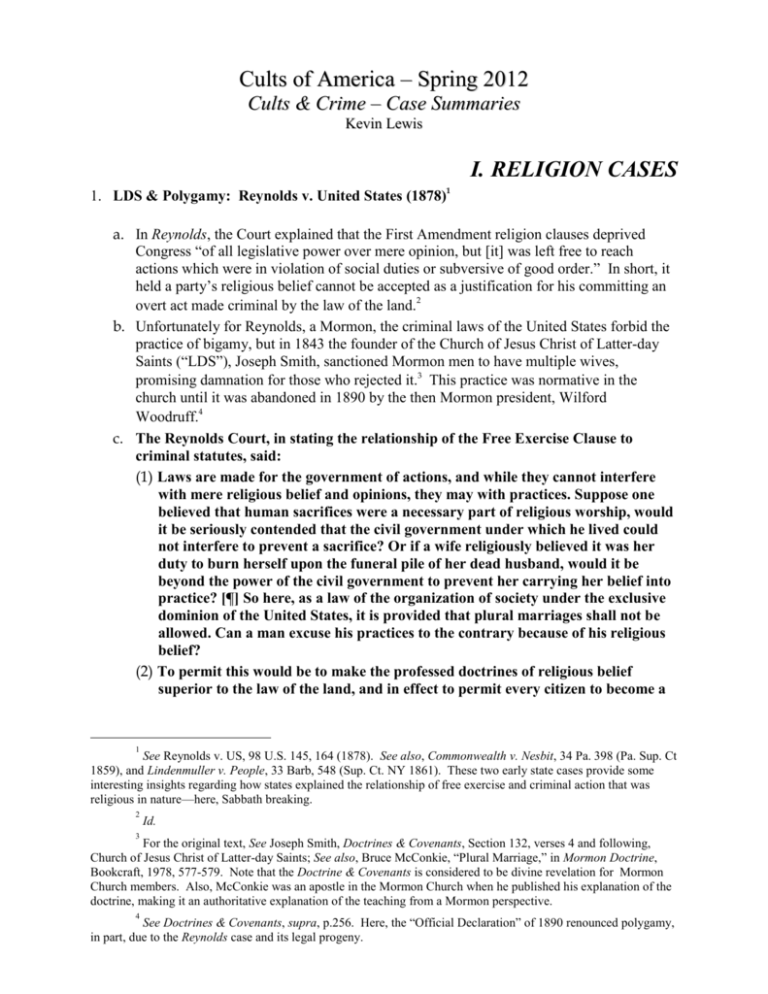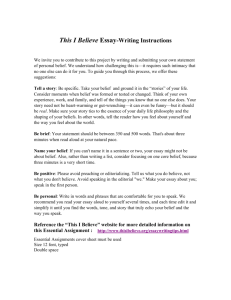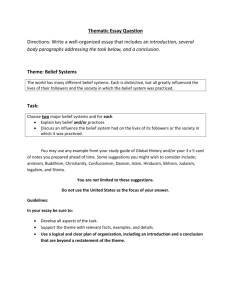
Cults of America – Spring 2012
Cults & Crime – Case Summaries
Kevin Lewis
I. RELIGION CASES
1
1. LDS & Polygamy: Reynolds v. United States (1878)
a. In Reynolds, the Court explained that the First Amendment religion clauses deprived
Congress “of all legislative power over mere opinion, but [it] was left free to reach
actions which were in violation of social duties or subversive of good order.” In short, it
held a party’s religious belief cannot be accepted as a justification for his committing an
overt act made criminal by the law of the land.2
b. Unfortunately for Reynolds, a Mormon, the criminal laws of the United States forbid the
practice of bigamy, but in 1843 the founder of the Church of Jesus Christ of Latter-day
Saints (“LDS”), Joseph Smith, sanctioned Mormon men to have multiple wives,
promising damnation for those who rejected it.3 This practice was normative in the
church until it was abandoned in 1890 by the then Mormon president, Wilford
Woodruff.4
c. The Reynolds Court, in stating the relationship of the Free Exercise Clause to
criminal statutes, said:
(1) Laws are made for the government of actions, and while they cannot interfere
with mere religious belief and opinions, they may with practices. Suppose one
believed that human sacrifices were a necessary part of religious worship, would
it be seriously contended that the civil government under which he lived could
not interfere to prevent a sacrifice? Or if a wife religiously believed it was her
duty to burn herself upon the funeral pile of her dead husband, would it be
beyond the power of the civil government to prevent her carrying her belief into
practice? [¶] So here, as a law of the organization of society under the exclusive
dominion of the United States, it is provided that plural marriages shall not be
allowed. Can a man excuse his practices to the contrary because of his religious
belief?
(2) To permit this would be to make the professed doctrines of religious belief
superior to the law of the land, and in effect to permit every citizen to become a
1
See Reynolds v. US, 98 U.S. 145, 164 (1878). See also, Commonwealth v. Nesbit, 34 Pa. 398 (Pa. Sup. Ct
1859), and Lindenmuller v. People, 33 Barb, 548 (Sup. Ct. NY 1861). These two early state cases provide some
interesting insights regarding how states explained the relationship of free exercise and criminal action that was
religious in nature—here, Sabbath breaking.
2
Id.
3
For the original text, See Joseph Smith, Doctrines & Covenants, Section 132, verses 4 and following,
Church of Jesus Christ of Latter-day Saints; See also, Bruce McConkie, “Plural Marriage,” in Mormon Doctrine,
Bookcraft, 1978, 577-579. Note that the Doctrine & Covenants is considered to be divine revelation for Mormon
Church members. Also, McConkie was an apostle in the Mormon Church when he published his explanation of the
doctrine, making it an authoritative explanation of the teaching from a Mormon perspective.
4
See Doctrines & Covenants, supra, p.256. Here, the “Official Declaration” of 1890 renounced polygamy,
in part, due to the Reynolds case and its legal progeny.
CO A
CULTS CASE SUMMARIES
Page 2
law unto himself. Government could exist only in name under such
circumstances.5
d. The incipient pronouncements of the Reynolds Court matured in 1890 in Davis v. Beason.
There, in one of the last Mormon polygamy cases—before its rejection by the LDS
church—the Court held, “however free the exercise of religion may be, it must be
subordinate to the criminal laws of the country, passed with reference to actions regarded
by general consent as properly the subjects of punitive legislation.”6 However, a state can
only forbid a religious activity when it poses a “substantial threat to public safety, peace
or order.”7
e. In sum, the Court opined that to grant an absolute exemption to a criminal statute in
all cases for someone’s religious belief—even if sincerely held—would eliminate the
concept of government itself. It could theoretically reduce society to anarchy and
autonomianism with each person his own judge and jury. Civilization would cease to
exist under these circumstances. And this is not permissible.
2. Law May Limit Free Exercise of Religion: Employment Division v. Smith (1990)
a. In Employment Division v. Smith, , the United States Supreme Court essentially shifted
the mode whereby it scrutinized free exercise jurisprudence. There the Court upheld a
state law of general applicability criminalizing peyote use. It was applied to deny
unemployment benefits to Native American Church members who lost their jobs because
of such use. Here, in doing so, the Court reduced the degree of scrutiny for free
exercise cases, holding that “generally applicable, religion-neutral laws that have the
effect of burdening a particular religious practice need not be justified by a
compelling governmental interest.”8 The 5-4 majority elaborated that “the right of free
exercise does not relieve an individual of the obligation to comply with a valid and
neutral law of general applicability on the ground that the law proscribes (or prescribes). .
. conduct that his religion prescribes (or proscribes).”9
b. Thus, in the Smith holding, the Court declined to apply the Sherbert10 test that inquires,
first, whether the statute in issue substantially burdens a religious practice, and if it does,
5
Id. at pp. 166-167.
6
See Davis v. Beason, 133 U.S. 333, 342 (1890); overruled on other grounds by Romer v. Evans, 517 U.S.
620, 633-634 (1996). See also Cantwell v. Connecticut, 310 U.S 296, 306-307 (1940), [Under the cloak of religion,
people may not commit frauds with impunity upon the public. Penal laws are available to punish such conduct.
Thus, a state may protect its citizens from fraudulent solicitation by requiring a stranger in the community, before
permitting him publicly to solicit funds for any purpose, to establish his identity and his authority to act for the cause
which he purports to represent. The state is likewise free to regulate the time and manner of solicitation generally, in
the interest of public safety, peace, comfort or convenience.].
7
8
9
Sherbert v. Verner, 374 U.S. 398, 403 (1963).
See Employment Division v. Smith, 494 U.S. 872, 886 (1990).
Id. at p. 879.
10
See Sherbert v. Verner, supra, 374 U.S. 398. This case is the origin of the “give an exemption where
feasible” test. Here, a Seventh Day Adventist was terminated and refused unemployment benefits for refusing to
work on Saturday. With the strict scrutiny standard in place, the Court found that the state failed to demonstrate
Copyright © 2012 by Kevin Alan Lewis
All Rights Reserved
CO A
CULTS CASE SUMMARIES
Page 3
whether the burden is justified by a compelling government interest. Here, the divided
Rehnquist Court seemed to say that any generally applicable criminal statute may be
enforced—even one that completely proscribes the religious behavior—if the religious
consequence was unintended by the government. However, this rule only applies to
unintended effects of burdening the free exercise of religion. If the government purposes
to burden a religious practice, traditional strict scrutiny applies.11 Thus, the Court made it
easier to prosecute religious fraud by lowering the level of scrutiny, but the population
was not ready for this quite yet.
3. The Sincerity Test: U.S v. Ballard
a. The seminal case for the sincerity test is the 1944 case of U.S. v. Ballard. There, the
Supreme Court considered the issue of criminal prosecution of fraud by a religious
corporation. The Ballards were indicted and convicted for using and conspiring to use
the United States mail to defraud by organizing and promoting the I Am Movement. The
specific charge was that they formed corporations, distributed and sold literature, and
solicited money and memberships in the I Am Movement “by means of false and
fraudulent representations, pretenses and promises.”12
b. Guy and Edna Ballard claimed to be the messengers of Saint Germain. Guy Ballard,
particularly, further claimed to have directly spoken with Jesus Christ, and that Guy—
along with Saint Germain and Jesus Christ—had supernatural powers, including the
power to heal sicknesses, and had in fact used them to heal sicknesses classified by the
then extant medical community both as curable and incurable.13 The prosecution’s
allegation was that they “well knew that all of said aforementioned representations were
false and untrue.”14 The Ballards claimed the prosecution was a violation of their free
exercise rights.
c. The Court’s evaluation is the model employed today by prosecutors. It is the paradigm or
archetype for the salvation or damnation of religious criminals—jurisprudentially
speaking, of course. In overruling the Court of Appeals and affirming the District Court
Judge’s ruling, it held that the issue of the “defendants’ good faith” was the essential
question. The jury could only be charged with determining whether or not the defendants
“honestly and in good faith believed” their doctrines and “that the benefits which they
represented would flow from their belief to those who embraced and followed their
teachings.” If not, the jury must determine whether the representations were “mere
how granting an exemption to Seventh Day Sabbatarians would prevent them from achieving their unemployment
compensation objective.
11
See Church of the Lukumi Babalu Aye v. City of Hialeah, 508 U.S. 520 (1993); Here, the court struck
down a city ordinance that was intended to prevent members of the Santerian religion from practicing ritual, animal
sacrifice within the city limits. The Court held that when a government purposefully acts to interfere with religious
conduct qua religious conduct, it will be subjected to “the most rigorous of scrutiny” and will rarely survive. [By
the way, the late Desi “Ricky Ricardo” Arnaz, of Cuban descent, crooned the tune of this Santerian god on the “I
Love Lucy” show.]
12
13
14
See U.S. v. Ballard, 322 U.S. 78, 79 (1944).
Id. at pp. 79-80.
Id.
Copyright © 2012 by Kevin Alan Lewis
All Rights Reserved
CO A
CULTS CASE SUMMARIES
Page 4
pretenses without honest belief on the part of the defendants” that “were made for the
purpose of procuring money.”15 If the latter, they could be prosecuted.
d. Thus, courts may only examine sincerity, not verity. And the Court so reasoned
because, “Heresy trials are foreign to our Constitution.” And even though the
doctrine proffered by the Ballards seemed preposterous, “if those doctrines are
subject to trial before a jury charged with finding their truth or falsity, then the
same can be done with the religious beliefs of any sect.” And if a jury attempts that
task, “they enter a forbidden domain” because the First Amendment “does not
select any one group or any one type of religion for preferred treatment.”16
e. Since Ballard, the courts have affirmed the “sincerity” doctrine many times—even in
non-criminal cases.17 They have considered it in cases of whether (1) to grant a tax
exemption, (2) to grant an exemption from school immunization programs, (3) to protect
prisoners’ religious practices, (4) to protect unemployment benefits, (5) to prosecute
defamation, (6) to determine child support, (7) to determine contempt of court, and (8) to
determine civil fraud.18 Thus, the Sincerity Test has proved itself versatile in prosecuting
a wide variety of religious offenses.
4. But what about the unusual or extreme circumstances? Could Ballard be universally applied
in all religion cases? Consider the following scenario. What if, on the determined day of
worship, an individual gazes intently into his own mirror and begins the reflexive, liturgical
rendition of “How Great Thou Art”—worshipping himself, with no other followers? Can
this possibly be a sincere religious belief? To this, the Court has answered affirmatively. 19 In
fact, the extent of the religious sincerity exemption possibly reaches Non-theistic and
Atheistic religions.20 So even though there are no cases yet decided in these areas, who
knows what the future holds—well, maybe the Psychic Friends.
15
16
Id. at p. 84.
Id. at pp. 86-87.
17
For a quasi-recent Supreme Court case upholding the Ballard “Sincerity Test,” see, Hernandez v.
Commissioner, 490 U.S. 680, 693 (1989). Here, in another Scientology case, the Court held that under the First
Amendment, the IRS can reject otherwise valid claims of religious benefit only on the ground that a taxpayers’
alleged beliefs are not sincerely held, but not on the ground that such beliefs are inherently irreligious.
18
See Senn, supra, at p. 334.
19
See Frazee v. Illinois Dept. of Employment Security, 489 U.S. 829 (1989). [A sincerely held religious
belief is valid for the purpose of free exercise analysis, even if the person belongs to no sect at all.]
20
See Torasco v. Watkins, 367 U.S. 488 (1961). [Maryland constitutional requirement of declaration of
belief in existence of God as test for office invaded freedom of belief and religion of appointee to office, in violation
of the First and Fourteenth Amendments to United States Constitution.]
Copyright © 2012 by Kevin Alan Lewis
All Rights Reserved






